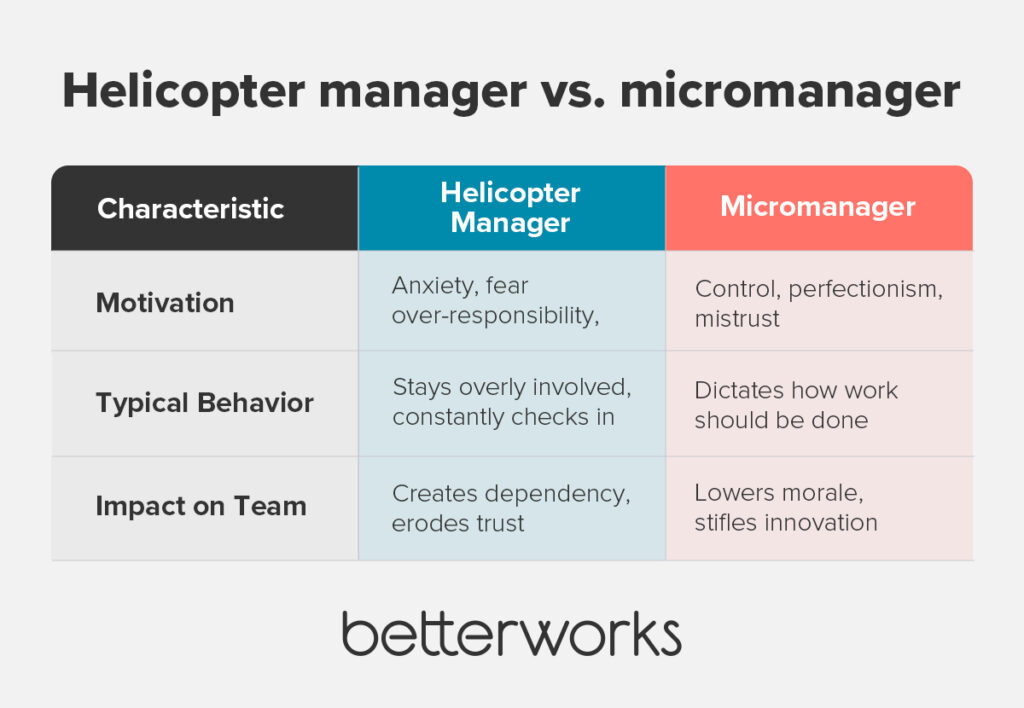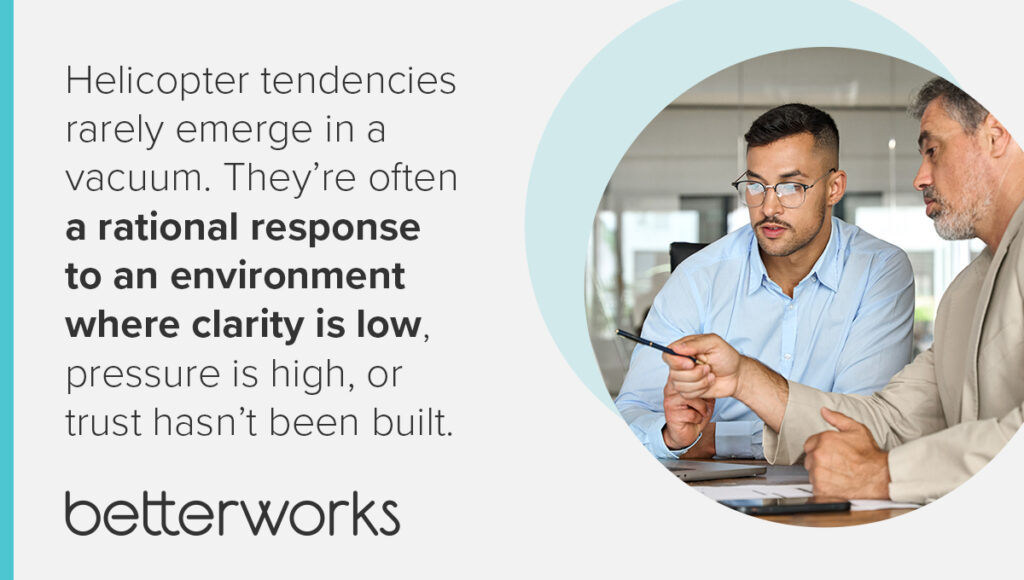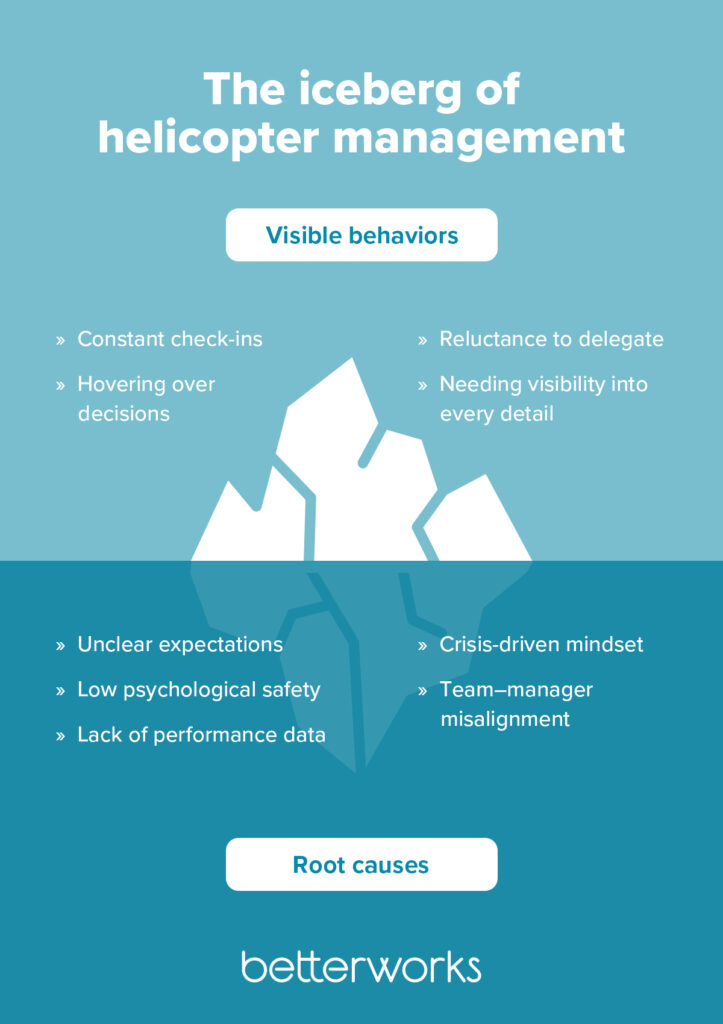High-performing teams need support, not surveillance. But in today’s high-stakes, visibility-hungry workplaces, the line between the two can start to blur.
Managers are checking in constantly, reviewing work multiple times, and hesitating to delegate. Well-meaning leaders are caught in a cycle of over-involvement that slows performance, creates tension, and quietly erodes trust.
Owl Labs’ State of Hybrid Work report found that 46% of workers say their companies increased productivity tracking in the past year. At the same time, 89% of U.S. knowledge workers report rising workplace anxiety. When performance becomes harder to measure—and pressure to deliver stays high—managers default to what feels safe.
At the same time, what looks like an individual manager problem is often a system problem. Helicopter management tends to surface when your performance culture lacks clarity, safety, or trust.
Helicopter manager definition
A helicopter manager is a leader who stays too close to the work by overseeing tasks, double-checking progress, and stepping in before their team has a chance to solve problems on their own. The term echoes helicopter parenting, where support tips into control.
Unlike micromanagers, helicopter bosses are often driven by anxiety, not distrust. They want their teams to succeed, but their need to stay involved ends up undermining that very goal.
This behavior isn’t always obvious. It might start with a few “quick check-ins,” a rewritten slide deck, or a request to preview low-risk work. Over time, though, it creates a culture of over-dependence, slows execution, and signals that autonomy isn’t safe.
In high-pressure, low-visibility environments—especially with remote working—hovering can start to feel like responsible leadership. But left unaddressed, it becomes a costly habit for individual managers and the performance culture around them.
Helicopter manager vs. micromanager
At first glance, helicopter managers and micromanagers might look the same: Both tend to overstep, second-guess, and slow their teams down. Both styles reduce autonomy. But understanding the why behind the behavior is key to fixing it.
Helicopter managers are usually driven by anxiety or over-responsibility. They want to protect their teams, avoid mistakes, and stay visible in high-stakes environments. Helicopter tendencies can often be coached and redirected, especially when they’re rooted in a lack of support.
Micromanagers, by contrast, are often fueled by perfectionism or mistrust, enforcing rigid control over how every task is done. Micromanagement, on the other hand, may signal deeper mindset issues around control and trust that require longer-term culture work.

5 tell-tale signs of helicopter management
Helicopter management doesn’t always look like overreach. In fact, it often stems from care: managers want to stay helpful, responsive, and present. But in high-pressure environments, that helpfulness can tip into hovering, especially when leaders lack clarity or confidence in what’s expected.
Here are a few patterns to watch for:
- Constant check-ins that interrupt flow. Frequent Slack pings, Team messages or “just checking in” calls, even when no blockers exist.
- Reluctance to delegate key tasks. Managers who prefer to “just do it themselves,” even when their team members have the skills.
- Discomfort with independent work. A need to stay in the loop on every detail, especially near deadlines or reviews.
- Rewriting or redoing work after it’s been assigned. Jumping in early, offering unsolicited revisions, or solving problems before the team can.
- Decision delays due to approval bottlenecks. Teams slow down or hesitate because they expect intervention from above.
If these behaviors show up across multiple teams, they may be more than individual quirks. They may be symptoms of a workplace culture where performance is monitored more than it’s enabled.

Root causes of helicopter management culture
Helicopter tendencies rarely emerge in a vacuum. They’re often a rational response to an environment where clarity is low, pressure is high, or trust hasn’t been built. When managers lack the tools, data, or safety to lead with confidence, hovering becomes a coping mechanism.
Lack of clarity
When goals, roles, or performance expectations are unclear, managers compensate by staying close to the work. Over-checking becomes a stand-in for alignment, but it also chips away at team confidence and autonomy.
Low psychological safety
In cultures where mistakes are penalized or failure is avoided at all costs, managers are less likely to let their teams operate independently. Hovering becomes a form of protection for themselves and their people even if it adds pressure instead of relieving it.
Inadequate performance data
When managers don’t have access to meaningful, real-time performance insights, they default to what they can see. Activity becomes a stand-in for impact. And visibility becomes the priority, even when it’s counterproductive.
Crisis mindset
In high-growth or high-pressure environments, urgency can distort decision-making. Hovering starts to feel like leadership. But when everything is a fire drill, constant oversight creates bottlenecks instead of breakthroughs.
Team–manager misalignment
Some managers crave control. Some teams thrive on autonomy. Without intentional support and coaching, that mismatch leads to tension. And managers, unsure how to adapt, may overcorrect by getting more involved.

Why helicopter management hurts more than it helps
On the surface, hovering can look like commitment. Managers are present, engaged, and eager to support. But beneath that intent is a pattern that undermines trust, stalls progress, and drives good people out the door.
The trouble starts small: an extra review, a few too many check-ins, a manager who always wants to be CC’d. But these behaviors send a clear message: You’re not trusted to run with this. And that message, repeated over time, reshapes how teams operate.
Employees become hesitant. Decisions slow down. High performers disengage—not because they don’t care, but because there’s no room to lead from where they are.
Burnout rises
Constant oversight wears down top performers, especially those who thrive on autonomy.
Decisions bottleneck
When every move requires approval, innovation and execution slow to a crawl.
Confidence erodes
Teams hesitate to act independently, afraid of being overruled or reworked.
Engagement drops
Hovering replaces trust with tension, and even well-meaning managers create distance.
Growth stalls
When people aren’t given space to learn through experience, development flatlines.
Helicopter management doesn’t just create friction. It chips away at the culture you’re trying to build: one where people feel trusted, capable, and empowered to lead from every level.

5 steps to help managers become high-trust leaders
Managers often hover when they’re navigating uncertainty, unclear goals, invisible progress, or a lack of support. To help them lead with trust, HR needs to provide more than advice. They must design organizational structures that enables high performers.
1. Set clear goals and outcomes
When expectations are vague, managers tend to track every detail. Clear, outcome-based goals, established through frameworks like OKRs, shift focus from activity to impact, making space for autonomy.
2. Build feedback into the flow of work
Ongoing conversations reduce the anxiety that leads to over-monitoring. HR leaders can help managers be better coaches by training them to give regular, structured, and meaningful feedback.
3. Use data to drive employee productivity
Without performance insights, managers default to visibility as a proxy for progress. Reliable, real-time data helps them drive employee productivity without hovering.
4. Create psychological safety
Managers are more likely to let go when they know it’s safe to fail, learn, and course-correct. Model transparency at the leadership level and reward thoughtful risk-taking to make trust contagious.
5. Reinforce better habits with better tools
Develop systems that encourage coaching, alignment, and accountability. A manager coaching checklist can help remind leaders of the essentials.
Fix the system, not just the managers
When managers don’t have the clarity, data, or support they need, hovering starts to feel like the only way to stay in control. The solution isn’t to single out individuals. It’s to strengthen the system around them.
Start by reexamining how success is defined and communicated. When goals are ambiguous or constantly shifting, over-monitoring fills the gap. Clear, outcome-based expectations create space for autonomy without sacrificing accountability.
Then, look at what your organization actually rewards. If managers are praised for being in every detail, they’ll keep showing up that way. But if you recognize alignment, trust, and team performance, behavior will follow.
Finally, invest in systems that support modern management. Managers shouldn’t have to choose between being hands-on and being out of the loop. When they’re equipped with tools for coaching and visibility, they can step back and still stay connected.
Want to enable more effective, less anxious leadership? Our free checklist offers practical coaching strategies for today’s modern managers.
Help your managers build trust without losing sight of performance




